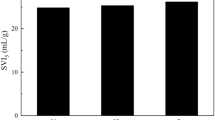Abstract
The aim of this work was to establish a relation between the mean cellular retention time and the ability of activated sludge to remove phosphate and ammonium. A sequencing batch reactor (SBR) with a total volume of 1.94 m3 was fed with municipal wastewater and was operated under four different organic loading rates to obtain sludge ages of 23, 16, 6, and 3 days. The operational strategy included fill, anaerobic, aerobic, settling and draw phases. The experimental work lasted 445 days. Biological phosphate removal was achieved with sludge ages from 6 to 23 days. The highest PO4-P removal rate observed was of 98% and corresponds to a 16-day sludge age; phosphate removal increased with the sludge age. A sludge age of 3 days resulted in a chemical oxygen demand (COD) removal rate of 81% and a sludge age of 23 days in a removal rate of 99%. Full nitrification was observed with a sludge age of 16 days. Nitrification increased with the sludge age. The 3-day sludge age did not allow nitrification. The phosphate concentrations in the biomass were inversely proportional to the sludge age.
Similar content being viewed by others
Author information
Authors and Affiliations
Additional information
Received: 21 June 1999
Rights and permissions
About this article
Cite this article
Bernal-Martínez, A., González-Barceló, Ó. & González-Martínez, S. Nutrient removal and sludge age in a sequencing batch reactor. Bioprocess Engineering 23, 41–45 (2000). https://doi.org/10.1007/s004499900118
Issue Date:
DOI: https://doi.org/10.1007/s004499900118




